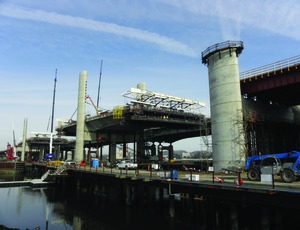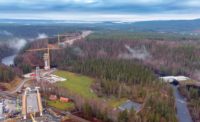

An extradosed bridge—often described as a hybrid of a cable-stayed and a box-girder structure—now stretches across the Quinnipiac River in New Haven, Conn., as the crown jewel of a $2-billion, 7.2-mile-long Interstate 95 improvement program. Project officials say the extradosed design, rare in the United States, offered a number of space- and cost-saving advantages for this particular location while satisfying the public desire for a signature bridge.
The Connecticut Dept. of Transportation launched its I-95 New Haven Harbor Crossing Corridor Improvement Program in 2000. ConnDOT is reconstructing the I-91/Route 34 interchange, adding a new 1,700-ft-long steel-girder flyover into New Haven and a new commuter rail station. The old steel-plate girder Q Bridge, built in the 1950s for 40,000 daily vehicles, now carries 140,000.
In 2006, ConnDOT received no bids for the 1,012-ft-long, 10-lane Q Bridge, due largely to concerns over the steep liquidated damages tied to 28 project milestones (ENR 2/19/07 p. 14). With program manager Parsons Brinckerhoff, "we went back and broke the contract into three major pieces: sewer relocation, the north-bound approach and some foundation work, and the south-bound approach plus the interchange," says John Dunham, ConnDOT's supervising engineer.
A joint venture of Cianbro Corp. and The Middlesex Cos. completed its $137-million contract for the 515-ft-long main span's foundations and north-bound approach last year on budget and a month early, he says. Middlesex also completed a $20-million contract to relocate a 46-in.-dia sewer main carrying up to 60 million gallons a day, requiring a 1,800-ft-long directional bore.
Foundation work included friction piles for the interchange and west approach, plus a 450-ft-deep bore through weak soils. "The fill is variable, with urban fill, pumped sand and contaminated material," says Joseph D'Agostino, deputy project manager for Parsons Brinckerhoff. The geotechnical conditions called for a $13-million contract, held by L.G. DeFelice Inc., to do preloading and drainage in anticipation of settlement. The site is surrounded by a port terminal, river traffic and an airport that required a minimal tower height to accommodate air traffic. The towers rise 75 ft above the deck.
In 2009, ConnDOT re-opened bids for the Q Bridge, also named the Pearl Harbor Memorial Bridge. This time, three teams bid. The joint venture of Walsh Construction Co. and PCL Civil Constructors left $33 million on the table with its $417-million bid, opting for concrete over steel (ENR 6/15/09 p. 16). The two 249-ft-long side spans are composed of steel-plate girders.
A standard cable-stayed structure would require higher towers, and a conventional girder bridge would require bigger girder depths. The cast-in-place segments here are 12 ft deep, 100 ft wide and 14.5 ft long, says Dunham. "You get a wider span with the same clearance and narrower box sections," he adds.
In URS Corp.'s design, the wire-carrying cables are placed outside the girders and on the main concrete towers, as opposed to high up on tall towers. Both the girders and the wire cables carry the loads.
The contractor acquired a specialized boom crane to place segments in areas where there is limited overhead room due to the new bridge's proximity to the old one. Crews also must work around overhead electrical lines, underground tank farms and river traffic. They have limited periods to install the 8-ft-dia drilled shaft foundations, driven as deep as 200 ft, says Matt Persing, PCL's project manager for marine works. The 19 drilled shafts were built with an oscillating hammer that uses three hydraulic cylinders to align, twist and advance each foundation element into the ground.
Once the north-bound lanes of the new bridge are completed later this year, the team proposes to demolish the existing south-bound lanes of the old bridge, shifting traffic to the old inner northbound lanes. The old inner north-bound traffic would then shift to the new lanes.
O&G Industries and Tutor Perini have begun a $360-million contract to reconstruct the interchange, providing a two-lane connection to I-91 and constructing 21 bridges. Walsh Construction completed the Route 34 flyover in a $91-million breakout contract early on.
Breakouts such as these allowed ConnDOT to keep work flowing while reconfiguring the contracts to reduce the levels of potential liquidated damages, says Dunham.
Walsh/PCL has two major milestones to meet, with a potential for $5 million in incentives/disincentives based on a 2015 completion date.



Post a comment to this article
Report Abusive Comment